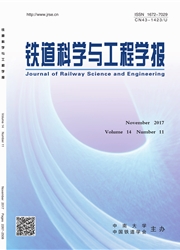

 中文摘要:
中文摘要:
为提升过饱和状态下交叉口群交通信号控制的效率,提出了一种基于NSGA-Ⅱ算法的信号配时优化方法.交叉1:7群关键路径上通行车数最大及平均排队比最小被选择为过饱和状态信号配时方法的优化目标.应用基于VISSIM软件信号控制程序接口的仿真环境,在输入实际观测数据的情况下,对所提算法和Synchro配时优化软件所生成的信号配时方案的效率进行对比.结果表明,所提出算法生成的信号配时方案能更有效地管理过饱和状态下交叉口群的交通流,具有优化过饱和状态信号配时方案的能力.
 英文摘要:
英文摘要:
In order to improve the efficiency of traffic signal control for an over-saturated intersection group, a nondominated sorting genetic algorithm Ⅱ(NSGA-Ⅱ) based traffic signal control optimization algorithm is proposed. The throughput maximum and average queue ratio minimum for the critical route of the intersection group are selected as the optimization objectives of the traffic signal control for the over-saturated condition. The consequences of the efficiency between traffic signal timing plans generated by the proposed algorithm and a commonly utilized signal timing optimization software Synchro are compared in a VISSIM signal control application programming interfaces (SCAPI) simulation environment by using real filed observed traffic data. The simulation results indicate that the signal timing plan generated by the proposed algorithm is more efficient in managing oversaturated flows at intersection groups, and, thus, it has the capability of optimizing signal timing under the over-saturated conditions.
 同期刊论文项目
同期刊论文项目
 同项目期刊论文
同项目期刊论文
 期刊信息
期刊信息
